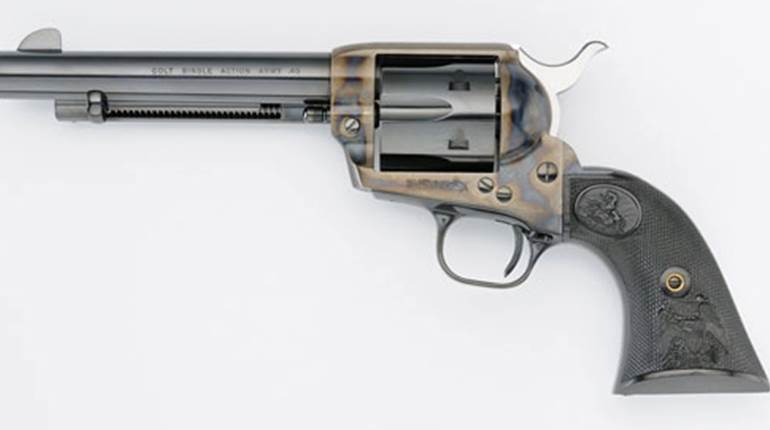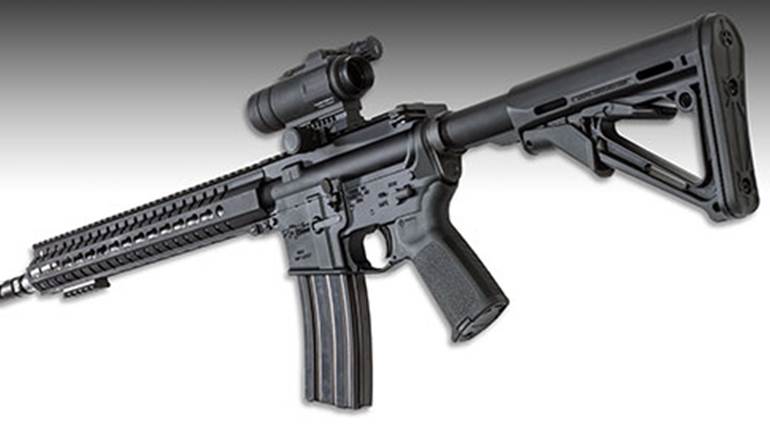- NRA Staff

Gallery

Hornady 2 3/4-inch SST
The Hornady 2 3/4-inch, 20-gauge SST Sabot Slug ammunition uses the same .50-cal., 300-grain SST bullet loaded in the firm’s .500 S&W Mag. factory loads. It is a lead-alloy core wrapped in a thin, gilding-metal jacket and topped with a soft, flexible tip. This sleek bullet exits with a catalog-listed muzzle velocity of 1,800 fps.With a fairly high ballistic coefficient of .200, it retains significant energy for long-range shots.
These high-tech, 20-gauge slugs may have resulted from trickle-down technology, but as they say, a rising tide floats all boats. They have changed the definition of 20-gauge shotgun slugs from “compromise” to the “leading edge of slug gun performance.”
Water: The slug exited the side of the container 3 inches from the bottom. This was likely due to an aiming error. It struck the rocks outside the container hard enough to slightly deform the bullet. After penetrating 25 inches of water, that was an impressive amount of energy left. Retained weight was 216.7 grains. The expanded diameter was 0.675 inches. The expanded diameter was slightly skewed due to the bullet striking the rocks. Measuring only the undamaged portion, the bullet was 0.684 inches. The measured weight of an unfired bullet with tip was 250.8 grains.
Perma-Gel: Penetration was 21 inches, and the retained weight was 240.6 grains. The expanded diameter was 0.752 inches. The bullet’s leading edge was tilted at an angle to the axis, but it penetrated straight.

Remington 3-inch AccuTip
Remington’s flagship slug is the Premiere AccuTip. This slug looks like it should be fired from a Starship Phaser instead of a shotgun. The slug’s jacket is made from the distinctively colored cartridge brass rather than the more common gilding metal or copper, and the lead core is bonded to that jacket. It doesn’t just have a plastic tip; it’s more like a plastic hat. The bullet is cylindrical and the plastic tip covers the entire diameter. This futuristic-looking plastic nosepiece has a series of holes around the circumference.
According to Greg Dennision, the Remington engineer who developed the slug, the holes are there to add drag. He discussed the bullet’s “center of pressure” and the benefits of adding drag, despite the more common approach of trying to eliminate it. The bottom line is that it is supposed to make the slug more accurate. Apparently it works, as this 3-inch slug load shot the best of the four loads I tested in the Benelli, with the average for five, three-shot groups under 2 inches. One very impressive group measured 0.90 inches.
Water: The slug was found on the bottom of the water container, so it was difficult to tell how much penetration was achieved. It was flattened out like a big washer with the diameter twice as wide as the bullet was long. The retained weight was 216.8 grains, and the expanded diameter was 0.77 inches. The measured weight of an unfired bullet with tip was 259.8 grains.
Perma-Gel: The slug penetrated 21 inches. Again, the slug was flattened out so it was wider than it was long. Retained weight was 252.2 grains, and the expanded diameter was 0.82 inches.

Winchester 3 Inch DualBond
Winchester was one of the early pioneers in the concept of sabot slugs. Back in 1991, it was the first big-name company to offer a wasp-waisted 50-cal. slug encased in a two-piece sabot. The design is still offered in 20 gauge. The company continued the trend as an early innovator using premium slugs in its shotgun loads. I was lucky enough to participate in some of the field testing when Winchester introduced the Nosler Partition Gold (NPG) slug in 1999. It was a 12-gauge-only product then and proved to be an outstanding deer load. Today Winchester offers it in a 20-gauge load featuring a 265-grain NPG slug.
The newest Winchester DualBond slug uses technology developed for handgun bullets; it is a double-jacket, bonded-core bullet that uses the reverse-taper jacket technology that is all the rage in defensive handgun bullets. As Winchester explains, “The outer jacket is designed for rapid and maximum upset and opens up to six dramatic segments. The inner jacket works with the bonded lead core and forms six additional segments at a controlled rate, resulting in a mushroom that is 1.5 times larger than the original bullet diameter. The heavy outer jacket is mechanically bonded to the inner bullet. The inner bullet utilizes a proprietary bonding process which welds the lead core to a second jacket, which results in a design that provides nearly 100 percent weight retention.”
The 3-inch load turned in 1,729 fps from the Benelli’s 24-inch barrel and an accuracy average for five, three-shot groups was just under 3 inches at 100 yards. Very impressive.
Water: The jacket and core separated. The outer jacket was shredded with the largest piece weighing 88.3 grains. The largest piece of the lead core was 87.3 grains. The rest was in small pieces.
Perma-Gel: Penetration was 19 inches, and the two jackets separated but were found very close to each other. The outer jacket weighed 102.8 grains and had an expanded diameter of 0.822 inches, while the inner core and jacket were 0.725 inches in length. The expanded diameter was 0.60 inches. Its inner core’s retained weight was 157.3 grains. The measured weight of an unfired bullet was 259.2 grains. I repeated the test in Perma-Gel with almost identical results.
Winchester sent me a recovered slug its engineers fired into 10 percent ballistic gelatin at 87 yards. According to my calculations that would have an impact velocity of about 1,415 fps, which is about 314 fps slower than the impact velocity of my tests. This bullet remained intact. The retained weight is 259.9 grains. The expanded diameter is 0.875 inches, not counting the points of the bottom jacket. The points measured 0.980 inches.

Federal Premium 3 inch Barnes Tipped Expander
Federal was an early innovator with the all-copper Barnes Expander slug in 12 gauge back in 1998. The Barnes Expander slug uses the proven performance of the Barnes muzzleloader bullet, which further modernized muzzleloader hunting. The larger version of the Barnes Expander used in a sabot slug configuration has proven to be extremely accurate. But its best feature is the outstanding terminal performance. The Barnes slug expands to almost double its diameter with six petals. Considering that even the 20-gauge version is already a half-inch in diameter, the slug makes a very big hole in a deer.
Make no mistake, big holes are what shooting deer with slugs is all about. The relatively low velocity of any shotgun slug will not cause the massive hydrostatic shock that a high-velocity rifle bullet can. Slugs, even the new slugs, kill deer the old-fashioned way: by punching big holes through vital areas. The Barnes punches a very big hole and almost always exits out the other side. I like that in a deer slug.
The current technological leader, the Tipped Barnes Expander, was introduced in 12 gauge in 2007, and Federal expedited the trickle-down process to the 20 gauge in the same year. The main reason for the tip is to improve external ballistics over the hollow-point Barnes Expander. The ballistic coefficient of the 20-gauge, tipped slug is .205, yet the Barnes hollow point is .185. What that means in the real world, using Federal’s published velocity for the 3-inch load, is 75 more ft.-lbs. of energy at 150 yards and slightly less bullet drop (under an inch). It is not a big difference, but every foot-pound counts. Compared to the Foster load, there is almost 11-inches less bullet drop with the tipped slug and 556 ft.-lbs. greater energy at 150 yards. The tipped slug actually has almost double the Foster slugs’ retained energy at that distance, 1,212 ft.-lbs. versus 656 ft.-lbs. That’s assuming, of course, that the Foster slugs even get there, as they tend to destabilize and “go to ground” after they fly much past 100 yards.
The polymer tip also helps the slug expand reliably at long range. The polymer tip fills the hollow point to initiate expansion without the need for tissue to fill the cavity. This ensures more reliable expansion by eliminating the variables of an open hollow point.
Water: The bullet was deformed on one side from hitting the bottom of the large plastic container. It actually punched a small hole in the bottom and there was some plastic imbedded in the bullet. No doubt that if the container had not been sitting on stone the bullet would have exited. It had impressive penetration through 28 inches of water and still enough energy to hit the bottom very hard. Retained weigh was 274.4 grains with the very small plastic piece trapped in the petals. The measured weight of the unfired slug with tip was 278.9 grains With the weight of the lost plastic tip, this was 100 percent weight retention. The expanded diameter was 0.83 inches. However, this was skewed a bit by the distortion of the bullet hitting the bottom.
Perma-Gel: At 23 inches, this bullet penetrated the deepest. It exhibited textbook expansion, and the expanded diameter was 0.875 inches. Its retained weight was 274.9 grains.



































